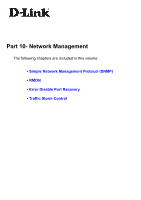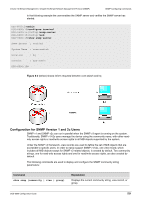D-Link DGS-6600-48TS Configuration Guide - Page 528
Simple Network Management Protocol (SNMP), Overview, An Introduction to SNMP Overview
 |
View all D-Link DGS-6600-48TS manuals
Add to My Manuals
Save this manual to your list of manuals |
Page 528 highlights
Volume 10-Network Management / Chapter 53-Simple Network Management Protocol (SNMP) Chapter Overview Chapter 53 Simple Network Management Protocol (SNMP) Chapter Overview The following topics are included in this chapter, please go to the topic for more detailed information: • Chapter Overview • An Introduction to SNMP Overview • SNMP Configuring Commands • Setting up Basic SNMP Server Information • Enabling the SNMP Server • Configuration for SNMP Version 1 and 2c Users • Configuration for an SNMP Version 3 Users • Configuring an SNMP Trap Recipient • Controls for Sending Specific Types of Traps • Configuring an SNMPv3 Engine ID • Configuration Examples • SNMPv2 With Trap Configuration Example • SNMP v3 with trap Configuration Example • List of Constants and Default Settings An Introduction to SNMP Overview SNMP (Simple Network Management Protocol) is a protocol that is used by an SNMP manager to communicate and manage an SNMP agent. SNMP is one of the available interfaces that a user can use to manage the device. The SNMP manager (Network Management System) is a station that runs SNMP client software. Each system that requires managing with SNMP has an Agent running on it, which is a software component that informs the SNMP manager of any system status changes that have occurred. The type of information that is sent to SNMP managers is controlled by MIB (Management information base) objects. SNMP uses three basic operations, with the SNMP manager carrying out two basic operations and the SNMP agent carrying out one basic operation. The SNMP manager performs GET or SET operations on the agent's MIB objects and the SNMP agent can send unsolicited traps to inform the SNMP manager of any new events. The Switch supports all three versions of SNMP; SNMP v1, SNMP v2c, and SNMP v3. Both SNMP v1 and SNMP v2c use the community-string based security model, which does not provide encryption and authentication for SNMP packets. SNMP v3 enhances the security model by providing encryption and authentication of SNMP packets. SNMP v3 also uses View-based Access Control, which allows different sets of MIB objects to be accessible to different sets of users. The features of the View-based Access Control Model (VACM) are described below: • Authentication- A checksum over the packet is computed by the sender and verified by the receiver. This verification ensures that the packet is valid and that is has originated from a valid source. • Encryption- Packets are encrypted to prevent eavesdroppers from learning the packet. DGS-6600 Configuration Guide 528















